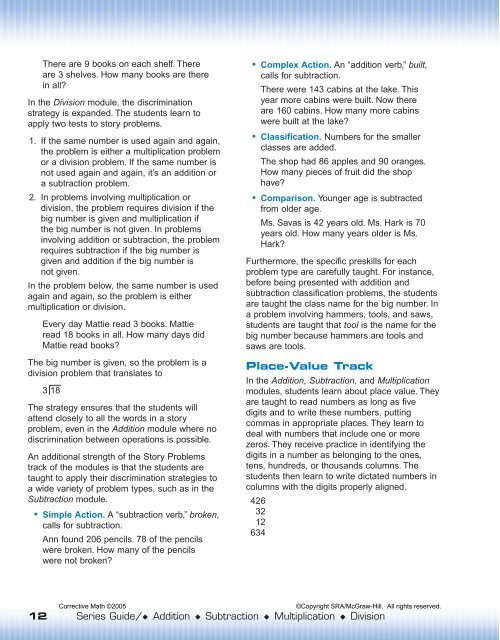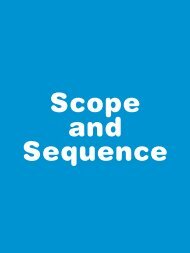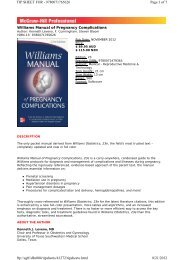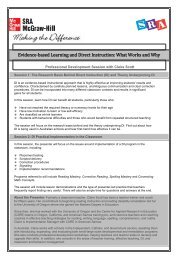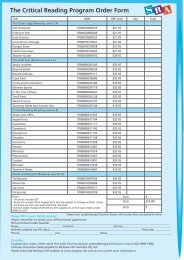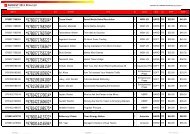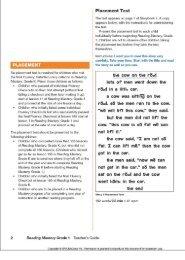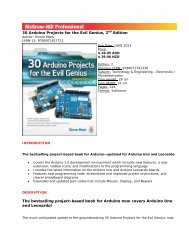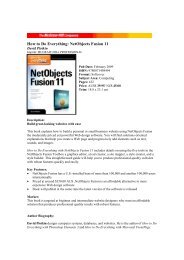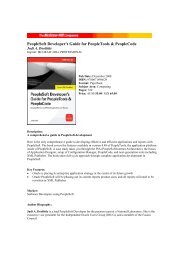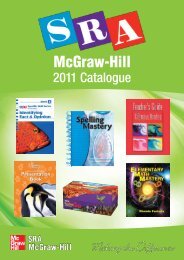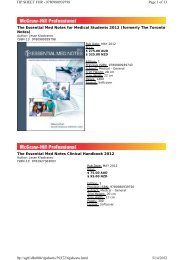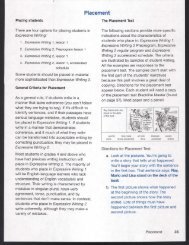Addition, Subtraction, Multiplication, Division - McGraw-Hill Australia
Addition, Subtraction, Multiplication, Division - McGraw-Hill Australia
Addition, Subtraction, Multiplication, Division - McGraw-Hill Australia
You also want an ePaper? Increase the reach of your titles
YUMPU automatically turns print PDFs into web optimized ePapers that Google loves.
There are 9 books on each shelf. Thereare 3 shelves. How many books are therein all?In the <strong>Division</strong> module, the discriminationstrategy is expanded. The students learn toapply two tests to story problems.1. If the same number is used again and again,the problem is either a multiplication problemor a division problem. If the same number isnot used again and again, it’s an addition ora subtraction problem.2. In problems involving multiplication ordivision, the problem requires division if thebig number is given and multiplication ifthe big number is not given. In problemsinvolving addition or subtraction, the problemrequires subtraction if the big number isgiven and addition if the big number isnot given.In the problem below, the same number is usedagain and again, so the problem is eithermultiplication or division.Every day Mattie read 3 books. Mattieread 18 books in all. How many days didMattie read books?The big number is given, so the problem is adivision problem that translates to3 18The strategy ensures that the students willattend closely to all the words in a storyproblem, even in the <strong>Addition</strong> module where nodiscrimination between operations is possible.An additional strength of the Story Problemstrack of the modules is that the students aretaught to apply their discrimination strategies toa wide variety of problem types, such as in the<strong>Subtraction</strong> module.• Simple Action. A “subtraction verb,” broken,calls for subtraction.Ann found 206 pencils. 78 of the pencilswere broken. How many of the pencilswere not broken?• Complex Action. An “addition verb,” built,calls for subtraction.There were 143 cabins at the lake. Thisyear more cabins were built. Now thereare 160 cabins. How many more cabinswere built at the lake?• Classification. Numbers for the smallerclasses are added.The shop had 86 apples and 90 oranges.How many pieces of fruit did the shophave?• Comparison. Younger age is subtractedfrom older age.Ms. Savas is 42 years old. Ms. Hark is 70years old. How many years older is Ms.Hark?Furthermore, the specific preskills for eachproblem type are carefully taught. For instance,before being presented with addition andsubtraction classification problems, the studentsare taught the class name for the big number. Ina problem involving hammers, tools, and saws,students are taught that tool is the name for thebig number because hammers are tools andsaws are tools.Place-Value TrackIn the <strong>Addition</strong>, <strong>Subtraction</strong>, and <strong>Multiplication</strong>modules, students learn about place value. Theyare taught to read numbers as long as fivedigits and to write these numbers, puttingcommas in appropriate places. They learn todeal with numbers that include one or morezeros. They receive practice in identifying thedigits in a number as belonging to the ones,tens, hundreds, or thousands columns. Thestudents then learn to write dictated numbers incolumns with the digits properly aligned.4263212634Corrective Math ©2005©Copyright SRA/<strong>McGraw</strong>-<strong>Hill</strong>. All rights reserved.12 Series Guide/◆ <strong>Addition</strong> ◆ <strong>Subtraction</strong> ◆ <strong>Multiplication</strong> ◆ <strong>Division</strong>


